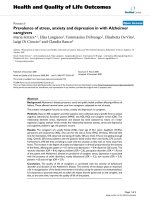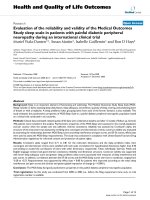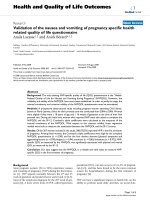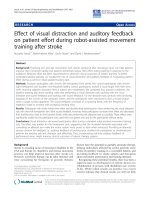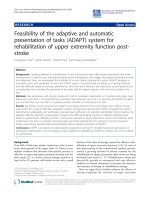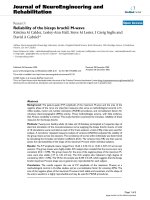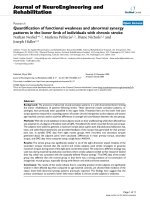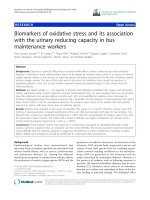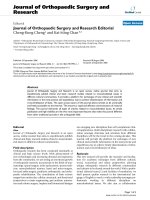Báo cáo hóa học: " Homogeneity of isosceles orthogonality and related inequalities" ppt
Bạn đang xem bản rút gọn của tài liệu. Xem và tải ngay bản đầy đủ của tài liệu tại đây (262.21 KB, 9 trang )
RESEARCH Open Access
Homogeneity of isosceles orthogonality and
related inequalities
Cuixia Hao
1*
and Senlin Wu
2
* Correspondence: haocuixia@hlju.
edu.cn
1
Department of Mathematics,
Heilongjiang University, Harbin,
150080, China
Full list of author information is
available at the end of the article
Abstract
We study the homogeneity of isosceles orthogonality, which is one of the most
important orthogonality types in normed linear spaces, from two viewpoints. On the
one hand, we study the relation between homogeneous direction of isosceles
orthogonality and other notions including isometric reflection vectors and L
2
-summand
vectors and show that a Banach space X is a Hilbert space if and only if the relative
interior of the set of homogeneous directions of isosceles orthogonality in the unit
sphere of X is not empty. On the other hand, we introduce a geometric constant NH
X
to
measure the non-homogeneity of isosceles orthogonality. It is proved that 0 ≤ NH
X
≤ 2,
NH
X
= 0 if and only if X is a Hilbert space, and NH
X
= 2 if and only if X is not uniformly
non-square.
Mathematics Subject Classification (2010):
46B20; 46C15
Keywords: Birkhoff orthogonality, homogeneity of isosceles orthogonality, Roberts
orthogonality, uniformly non-square
1 Introduction
We denote by X a real Banach space with origin o and norm ||·||, by B
X
and S
X
the
unit ball and unit sphere of X, respectively. When the dimension of X is two, B
X
and
S
X
are called the unit disc and unit circle of X, res pectively. For two linearly indepen-
dent points x and y in X,wedenotebyX
x,y
the two-dimensional subspace of
X spanned by x and y.
In a certain sense, we can say that it is the missing of an orthogonality type with “nice
property” that makes non-Hilbe rtian Banach spaces different f rom Hilbert spaces (cf.
characterizations of inner product spaces related to orthogonality types listed in [1], and
the surveys [2] and [3]). Due to this situation, many generalized orthogonality types have
been introduced into Banach spaces to act as substitutions of the orthogonalit y induced
by inner products in Hilbert spaces. Certain property (or properties) of the orthogonality
induced by an inner product is (are) missing from each of these generalized orthogonal-
ity types. For example, isosceles orthogonality introduced by James in [4], the one we
study in this p aper, is not homogeneous, where a vector x in X is said to be isosceles
ortho gonal to a vector y in X if the equality ||x + y|| = ||x-y|| holds (we write x ⊥
I
y for
this situation). James [4] proved that X is a Hilbert space if and only if isosceles ortho-
gonality is homogeneous, i.e., if and only if the implication x ⊥
I
y ⇒ x ⊥
I
ay holds for
each real number a. For the situation of Bi rkhoff orthogonality (cf. [5] and [6]), where a
Hao and Wu Journal of Inequalities and Applications 2011, 2011:84
/>© 2011 Hao and Wu; licensee Springer. This is an Open Access ar ticle distributed under the terms of the Crea tive Commons Attribution
License (http://creativecom mons.org/licenses /by/2.0), which permits unrestricted use, distribution, and reproduction in any medium,
provided the original work is properly ci ted.
vector x is said to be Birkhoff orthogonal t o y (denoted by x ⊥
B
y) if the inequality ||x +
ay|| ≥ ||x|| holds for each real number a, we know that this orthogon ality is not
symmetric, i.e., x ⊥
B
y does not necessarily i mply that y ⊥
B
x. We also need the notion of
Roberts orthogonality. A vector x is said to be Roberts orthogonal to another vector y
(denoted by x ⊥
R
y) if the equality ||x + ay|| = ||x-ay|| holds for each real number a
(cf. [7]). Roberts orthogonality implies both Birkhoff orthogonality and isosceles ortho-
gonality. More precisely, the implications x ⊥
R
y ⇒ x ⊥
B
y and x ⊥
R
y ⇒ x ⊥
I
y hold.
Roberts orthogonality is both homogeneous and symmetric, but it does not have the
existence property (cf. Example 2.1 in [4]): there exists a Minkowski plane (i.e., a real
two-dimensional Banach space) such that
x⊥
R
y
⇒||x|| ·||
y
|| =0
.
Although isosceles orthogonality is not homogeneous in general, it is possible that,
for a Banach space that is not a Hilbert s pace, there exists a vector x Î S
X
such that
the implication
∀
y
∈ X, x⊥
I
y
⇒ x⊥
R
y
holds. Such a unit vector x is said to be a homogeneous direction of isosceles ortho-
gonality.Inthefollowing,wedenotebyH
X
the set of all homogeneous directions of
isosceles orthogonality in X. In Section 2, we study the relation of homogeneous direc-
tion of isosceles orthogonality t o other notions including isometric reflection vectors
and L
2
-summand vectors (see Section 2 for the definitions) and prove a new character-
ization of Hilbert spaces.
In the meantime, we provide a quantitative characterization of the non-homogeneity
of isosceles orthogonality by introducing a new geometric constant NH
X
.Weshow
that NH
X
= 0 if and only if isosceles orthogonality is homogeneous and NH
X
=2if
and only if the underlying space is not uniformly non-square.
2 Homogeneous directions of isosceles orthogonality
First, we study the relatio n of homogeneo us directions of isosceles orthogonality to
other notions.
2.1 Relations to isometric reflection vectors and L
2
-summand vectors
A reflection on X is an operator defined as follows:
T
x,x
∗
: z → z − 2x
∗
(
z
)
·
x
, where x Î
X, x* Î X*,andx*(x)=1.Letx be a point in S
X
.Ifthereexistsapoint
x
∗
∈ S
X
∗
such
that the reflection
T
x
,
x
∗
is an isometry then x is said to be an isometric reflection vector
and x* is said to be the corresponding isometric reflection functional. For any isometric
reflection vector x, there is a unique isometric reflection functional x* corresponding
to it (cf. [8]). For the relation between isom etric reflection vectors and Roberts ortho-
gonality, Chan He et al. proved the following lemma.
Lemma 1 ([9]) LetXbearealBanachspace,xÎ S
X
,
x
∗
∈ S
X
∗
, and
T
x
,
x
∗
be a reflec-
tion. Then,
T
x
,
x
∗
is an isometric reflection if and only if
x⊥
R
H := {z : z ∈ X, x
∗
(
z
)
=0}
.
From Lemma 1, on e can see that the notions of “homogene ous direction of isosceles
orthogonality” and “isometric reflection vector” are closely connected. One may e ven
Hao and Wu Journal of Inequalities and Applications 2011, 2011:84
/>Page 2 of 9
expect that these two notions coincide. However, this is not true even when the under-
lying space is two-dimensional.
Example 1 Let X =(ℝ
2
, ||·||
∞
), x = (0,1), y = (1,0), and z = (2,1). Then, it is not diffi-
cult to verify that x is an isometric reflection vector. However, one can observe that x
∉ H
X
since x ⊥
I
z but
x ⊥
I
(
z/2
)
.
In the meantime, we have the following proposition.
Proposition 1 Le t X be a Minkowski plane and x Î H
X
. Then, x is an isometric
reflection vector.
Proof Let y beapointinS
X
such that x ⊥
I
y.Then,x ⊥
R
y since x Î H
X
.Recallthat
Roberts orthogonality implies Birkhoff ortho gonality. Hence x ⊥
B
y. Thus, there exists
afunctional
x
∗
∈ S
X
∗
such that x*(x)=1andx*(y)=0(cf.[6]).Then,
T
x
,
x
∗
is a reflec-
tion and the set H := {z Î X : x*(z) = 0} is precisely the line passing through -y and y.
Since Roberts orthogonality is homogeneous, we have x ⊥
R
H. Then, it follows from
Lemma 1 that
T
x
,
x
∗
is an isometry and x is an isometric reflection vector. □
Example 1 shows that the converse of Proposition 1 is not true in general, but it
holds when the underlying Minkowski plane is strictly convex. More precisely, we have
the following proposition.
Proposition 2 LetXbeaMinkowskiplane,xÎ S
X
be an isometric reflection v ector.
If there does not exist a nontrivial li ne segment con tained in S
X
and parallel to the line
passing through -x and x then x Î H
X
.
Proof Since x is an isometri c reflection vector, by Lemma 1, th ere exists a point y Î
S
X
such that x ⊥
R
{ay : a Î ℝ}. On the other hand, by the assumption of the proposi-
tion and Theorem 2.3 in [10] (see also [11]), for each number r >0,thereexistpre-
cisely two point s p and -p in X such that ||p|| = r and x ⊥
I
p hold. Clearly, these two
points have to be the points of inters ection of the line { ay : a Î ℝ} and the sphere
rS
X
.Thus,foreachpointz Î X satisfying x ⊥
I
z,wehavez =||z || y or z =-||z|| y.
Since Roberts orthogonality is homogeneous, this means that x ⊥
R
z. Thus, x Î H
X
. □
Proposition 1 does not hold in higher dimensional cases. See the following example.
Example 2 Let X =(ℝ
3
,||·||
∞
)andx = (1,1,1). Then, x Î H
X
, and it is not an iso-
metric reflection vector.
Proof Let y be an arbitrary point in S
X
such that x ⊥
I
y. Then, it i s clear that x and y
are linearly independent. Next, we show that x ⊥
R
y.
Assume that y =(a, b, g). Then, since y Î S
X
,max{|a|, |b|, |g|} = 1. W e only deal
with the case when |a| = 1, and the other two cases can be proved in a similar way.
By replacing y with -y if it is necessary, we may assume that a = 1. Then,
||x +
y
|| =max{2, |1+β|, |1+γ |} =
2
and
||x −
y
|| =max{|1 − β|, |1+γ |}
.
From the fact that x ⊥
I
y it follows that
|1 −
β
| =2or|1 −
γ
| =2
.
We only need to consider the subcase when b = - 1, and the other subcase when g =
-1 can be proved similarly.
Hao and Wu Journal of Inequalities and Applications 2011, 2011:84
/>Page 3 of 9
For any real number μ, we have the following equations:
|
|x + μ
y
|| =max{|1+μ|, |1 − μ|, |1+μγ |
}
and
||x −μ
y
|| =max
{
|1 − μ|, |1+μ|, |1 − μγ |
}.
Since
|1+μ
γ
|, |1 −μ
γ
|≤max{|1+μ|, |1 −μ|
}
we have that
|
|x + μ
y
|| = ||x −μ
y
||
,
which implies that x ⊥
R
y.
In the rest of the proof, we show that x is not an isometric reflection vector.
Otherwise, there exists a hyperplane H passing through the origin o such that x ⊥
R
H.Letz
1
=(-1,-1,1)andz
2
=(-1,1,-1).Then,itisclearthatx ⊥
R
z
1
and x ⊥
R
z
2
.
Since z
1
is the unique (except for the sign) point in
S
X
x,z
1
such that x ⊥
R
z
1
,andH
intersects
X
x,z
1
,wehavethatz
1
Î H. Similarly, z
2
Î H. However, for the point w =
(z
1
+ z
2
)/2, we have
||
x + w
||
=1,
||
x −w
||
=2,
which imply that
x
⊥
R
w
. This is a contradiction to the fact that H is a hyperplane in
X. □
Nevertheless, we have the following lemma.
Lemma 2 If x Î H
X
is a smooth point of S
X
then x is an isometric reflection vector,
and therefore, x is Roberts orthogonal to a hyperplane.
Proof By Lemma 1, it suffices to show that x is Roberts orthogonal to a hyperplane.
Since x is a smooth point, there exists a unique hyperplane H such that x ⊥
B
H.Inthe
following, we show that x ⊥
R
H.
For each vector z Î H\{o}, there exists a unit vector z’ Î X
x,z
such that x ⊥
I
z’.From
the relation x Î H
X
,itfollowsthatx ⊥
R
z’, which implies x ⊥
B
z’.Sincex is a smooth
point, either z/||z|| = z’ or z/||z|| = -z’ holds. Thus, x ⊥
R
z. The case when z = o is
trivial. □
Let M be a closed subspace of X. If there exists another closed subspace N of X such
that X = M ⊕ N and that, for each pair of points m Î M and n Î N, the equality
||
m + n
||
2
=
||
m
||
2
+
||
n
||
2
holds, then M is said to be an L
2
-summand subspace (cf. [12]). Note that, when M is
an L
2
-summand subspace, N is uniquely determined. Let x be a point in X. If the sub-
space spanned by x is an L
2
-summand subspace then x is said to be an L
2
-summand
vector.
Theorem 1 Let x Î S
X
be an L
2
-summand vector. Then, x Î H
X
.
Proof We denote by M the one-dimens ional subspace spanned by x,byN the closed
subspace of X such that X = M ⊕ N and that the equality
||
m + n
||
2
=
||
m
||
2
+
||
n
||
2
Hao and Wu Journal of Inequalities and Applications 2011, 2011:84
/>Page 4 of 9
holds for each pair of points m Î M and n Î N.Lety be an arbitrary point in X
such that x ⊥
I
y, y
M
Î M, and y
N
Î Nbethe two points such that y = y
M
+ y
N
. Then,
|
|x + y || =
||x + y||
2
=
||x + y
M
+ y
N
||
2
=
||x + y
M
||
2
+ ||y
N
||
2
and
||x −y|| =
||x − y||
2
=
||x − y
M
− y
N
||
2
=
||x −y
M
||
2
+ ||y
N
||
2
.
It follows that
||
x +
y
M
||
=
||
x −
y
M
||
.
This equation holds only if y
M
= o. Thus, we have that y = y
N
Î N. Next, we show that,
for each point z Î N, x ⊥
I
z. Actually, this is an easy consequence of the equations
|
|x + z|| =
||x + z||
2
=
||x||
2
+ ||z||
2
and
|
|x − z|| =
||x − z||
2
=
||x||
2
+ ||z||
2
.
Since N is a linear subspace of X,itfollowsthatx ⊥
R
z holds for each point z Î N.
We have shown that, for each point y Î X, x ⊥
I
y implies that x ⊥
R
y, i.e., x Î H
X
. □
2.2 A characterization of Hilbert spaces
Theorem 2 LetXbeaBanachspacewithdimX ≥ 2. Then, X is a Hilbert space if and
only if the relative interior of H
X
in S
X
is not empty.
Proof Clearly, if X is a Hilbert space then isosceles orthogonality coincides with
Roberts orthogonality, which implies that H
X
= S
X
.
Now assume that th e relative interio r of H
X
in S
X
, which is denoted by P,isnot
empty. By Theorem 2.2 in [8], it suffices to show that each point x in P is an isometric
reflection vector. By Lemma 2, we only need to show that each point x in P is a
smooth point.
Let x be an arbitrary point in P. Suppose to the contrary that x is not a smooth
point. Then, there exists a two-dimensional subspace Y containing x such th at x is not
a smooth point of S
Y
.Letw be a point in S
Y
such that x ⊥
B
w .Sincex is a relative
interior point of P, it is also a relative interior point of P ∩ S
Y
. Thus, there exist two
points u and v in S
Y
such that x is a relative interior point (with respect to S
Y
)ofthe
set
arc
(
u, v
)
:= {λu + μv : λ, μ ≥ 0}∩S
Y
⊂ P
.
Moreover, we may assume, without loss of generality, that v Î arc(x, w)andthat
each point of arc(u, v)\{x } is a smooth point. The points u and v are also chosen in a
way such th at there exist two numbers a
0
≥ 0, b
0
≤ 0 and that the relations u ⊥
B
(a
0
x
+ w )andv ⊥
B
(b
0
x + w) h old. I.e., we assume that the s upporting lines of B
Y
at u and
v both intersect the line passing through w and parallel to 〈-x,x〉.Let{u
n
}and{v
n
}be
two sequences such that
{u
n
}⊂arc(u, x):={λu + μx : λ, μ>0}∩S
Y
,
{υ
n
}⊂arc
(
v, x
)
:= {λv + μx : λ, μ>0}∩S
Y
,
Hao and Wu Journal of Inequalities and Applications 2011, 2011:84
/>Page 5 of 9
and
lim
n
→
∞
u
n
= lim
n
→
∞
v
n
= x
.
Then, there exist two sequences of numbers {a
n
} and {b
n
} such that
u
n
⊥
B
(
α
n
x + w
)
and v
n
⊥
B
(
β
n
x + w
).
By extracting two subsequences if it is necessary, we may assume, without loss of
generality, that there exist two numbers A and B such that
lim
n
→
∞
α
n
= B and lim
n
→
∞
β
n
= A
.
Then, since S
Y
is a closed convex curve, B ≥ A. Now, we have that
x⊥
B
(
Bx + w
)
and x⊥
B
(
Ax + w
).
Since x is not a smooth point, B >A. Recall that Roberts orthogonality implies Birkh-
off orthogonality. Thus,
u
n
⊥
R
(
α
n
x + w
)
and v
n
⊥
R
(
β
n
x + w
).
This implies that
u
n
⊥
I
(
α
n
x + w
)
and v
n
⊥
I
(
β
n
x + w
).
Thus,
x⊥
I
(
Bx + w
)
and x⊥
I
(
Ax + w
).
Since x Î H
X
, we have
x⊥
I
Bx + w
||Bx + w||
and x⊥
I
Ax + w
||Ax + w||
.
Due to the uniqueness property of isosce les orthogonality on the unit sphere, this is
impossible. It follows that x is a smooth point. □
3 A measure of non-homogeneity of isosceles orthogonality
In this section, we introduce the following measures of non-homogeneity of isosceles
orthogonality: the constant
NH
X
=sup
α>0
||x + αy|| −||x −αy||
α
: x, y ∈ S
X
, x⊥
I
y
and its local version for x Î S
X
NH
X
(x)=sup
α>0
||x + αy|| −||x −αy||
α
: y ∈ S
X
, x⊥
I
y
.
Now, the following result follows from Theorem 2 and the observation that x Î H
X
if and only if NH
X
(x)=0.
Theorem 3 Let X be a Banach space with dimX ≥ 2. If the relative interior of {x Î S
X
: NH
X
(x)=0}in S
X
is not empty then X is a Hilbert space.
For the discussion in this section, we ne ed to introduce the so called non-square
constant (or, James constant. Cf. [13] and [14]; see also [15] for a generalized version):
Hao and Wu Journal of Inequalities and Applications 2011, 2011:84
/>Page 6 of 9
J
(X):=sup{min{||x + y||, ||x − y||} : x, y ∈ S
X
}
=sup{||x −
y
|| : x,
y
∈ S
X
, x⊥
I
y
}.
For any Banach space X,wehave
√
2 ≤ J
(
X
)
≤
2
. It is well known that a Banach
space X is uniformly non-square if and only if J(X) < 2. Some preliminaries about ultra-
power are also neces sary. Let
U
be an ultrafilter on N. A sequence {x
n
}inX converges
to x with respect to
U
, denoted by
lim
U
x
n
= x
,if,foreachneighborhoodU of x,
{
i ∈ N : x
i
∈ U
}
∈
U
. The ultrapower of X, which is denoted by
˜
X
, is the quotient space
l
∞
(
X
)
/N
U
(
X
)
equipped with the quotient norm, where
l
∞
(X)=
(x
n
) ⊂ X : ||(x
n
)|| =sup
n∈N
||x
n
|| < ∞}
,
N
U
(X)=
(x
n
) ∈ l
∞
(X) : lim
U
||x
n
|| =0
,
and
|
|
˜
x|| = lim
U
||x
n
||
for
˜
x =
(
x
n
)
U
∈
˜
X
. For more information about ultra-techniques
in Banach space theory, we refer to [16] and [17].
First, we prove the following inequality between NH
X
and J(X).
Lemma 3 Let X be a Banach space with dimX ≥ 2. Then,
NH
X
≤ 2
(
J
(
X
)
− 1
).
Proof Let x and y be two arbitrary unit vectors that are isosceles orthogonal to each
other and a be an arbitrary positive real number. Without loss of generality, we may
assume that ||x + ay|| ≥ ||x - ay||. In the following, we distinguish two cases.
Case 1:0<a ≤ 1. It follows from the convexity of f(a)=||x + ay|| that
||x + αy|| − ||x −αy||
2
α
≤
||x + y|| − ||x||
1
≤ J(X) −1
.
Thus
||
x + αy
||
−
||
x − αy
||
α
≤ 2(J(X) −1)
.
Case 2: a > 1. By the triangle inequality, we have
||x + αy|| − ||x −αy||
α
≤
||x + y|| +(α − 1)||y|| −||x −y||
α
=1−
1
α
.
Similarly, we have
||x + αy|| −||x −αy||
α
≤
2
α
.
Thus,
||x + αy|| −||x −αy||
α
≤ min
α>1
1 −
1
α
,
2
α
≤
2
3
≤ 2(J(X) − 1)
.
The desired inequality now follows directly from the definitions of NH
X
and J(X). □
Lemma 4 Let X be a Banach space with dimX ≥ 2. If NH
X
=2then J(X)=2.
Proof If NH
X
= 2 then 2 = NH
X
≤ 2(J(X)-1)≤ 2. Thus J(X)=2. □
For the lower and upper bounds of NH
X
and NH
X
(x), we have the following
theorem.
Hao and Wu Journal of Inequalities and Applications 2011, 2011:84
/>Page 7 of 9
Theorem 4 Let X be a Banach space with dimX ≥ 2. Then,
0 ≤ NH
X
≤ 2 and 0 ≤ NH
X
(
x
)
≤ 2, ∀x ∈ S
X
.
NH
X
=0if and only if X is a Hilbert space a nd NH
X
=2if and only if X is not uni-
formly non-square.
Proof To prove the inequalities 0 ≤ NH
X
≤ 2, it suffices to show that 0 ≤ NH
X
(x) ≤ 2 hold
for each x Î S
X
, which follow from the following observation: for each number a >0,
||x + αy|| −||x −αy||
α
≤
|||x + αy|| −||x −αy|||
α
≤
min{2, 2α}
α
≤ 2
.
By Theorem 3, it is clear that if NH
X
=0thenX is a Hilbert space. Conversely, if X
is Hilbert space then isosceles orthogonality coincides with Roberts orthogonality,
which implies that NH
X
= 0. In the following, we prove that NH
X
=2ifandonlyifJ
(X)=2. By Lemma 4, we only need to show the implication J(X)=2⇒ NH
X
=2.
Suppose that J(X) = 2 holds. Then, there exist {x
n
}, {y
n
} ⊂ S
X
such that x
n
⊥
I
y
n
holds
for each n and
lim
n
→
∞
||x
n
+ y
n
|| =2
.
Let
˜
x =
(
x
n
)U
and
˜
y =
(
y
n
)U
. Then,
˜
x,
˜
y ∈ S
˜
X
and
||
˜
x +
˜
y
|| = ||
˜
x −
˜
y
|| =
2
. Thus, the unit
circle of the two-dimensional subspace
˜
X
˜
x,
˜
y
of
˜
X
is the parallelogram with
˜
x,
˜
y
, −
˜
y
,and
−
˜
y
as vertices. Then, for any number a, b ≥ 0 satisfying a + b >0, we have
|
|α
˜
x + β
˜
y|| =(α + β)
α
α + β
˜
x +
β
α + β
˜
y
= α + β
.
For each sufficiently large k Î N and each n Î N, let v
n,k
be a point in the unit circle
of
X
x
n
,
y
n
such that
|
v
n,k
− x
n
|| =
1
k
and that x
n
Î arc(v
n,k
,y
n
); let u
n,k
be a point in arc(x
n
,
y
n
)suchthatu
n,k
⊥
I
v
n,k
.Then,thereexist{a
n,k
}, {b
n
, k}, {g
n,k
}, and {h
n
, k} ⊂ (0, +∞)
such that x
n
= a
n,k
v
n,k
+ b
n,k
y
n
and u
n,k
= g
n,k
x
n
+ h
n,k
y
n
. By extracting subsequences if
it is necessary, we may assume that {u
n,k
}, {v
n,k
}, {a
n,k
}, {b
n,k
}, {g
n,k
}, and {h
n,k
}allcon-
verge as k tends to infinity.
Let
˜
u
k
=
(
u
n,k
)U
and
˜
v
k
=
(
v
n,k
)U
.Then,
˜
u
k
,
˜
v
k
∈ S
˜
X
˜x,˜
y
,
˜
u
k
⊥
I
˜
v
k
,and
||
˜
v
k
−
˜
x|| =
1
k
.More-
over,
˜
x ∈ arc
(
˜
v
k
,
˜
y
)
and
˜
u
k
∈ arc
(
˜
x,
˜
y
)
. It is not difficult to verify the following two equal-
ities
˜
v
k
= −
1
2k
˜
y +
1 −
1
2k
˜
x and
˜
u
k
=
1 −
1
2k
˜
y +
1
2k
˜
x
.
For sufficiently large k and
α ≤
1
2
k
, we have
1
α
(||
˜
u
k
+ α
˜
v
k
|| − ||
˜
u
k
− α
˜
v
k
||)
=
1
α
1 −
1
2k
−
α
2k
˜
y +
1
2k
+ α −
α
2k
˜
x
−
1 −
1
2k
+
α
2k
˜
y +
1
2k
− α +
α
2k
˜
x
=
1
α
1 −
1
2k
−
α
2k
+
1
2k
+ α −
α
2k
−
1 −
1
2k
+
α
2k
+
1
2k
− α +
α
2k
=2−
2
k
.
Hao and Wu Journal of Inequalities and Applications 2011, 2011:84
/>Page 8 of 9
Thus,
NH
X
≥ lim
n→∞
1
α
(||u
n,k
+ αv
n,k
|| − ||u
n,k
− αv
n,k
||
)
= lim
U
1
α
(||u
n,k
+ αv
n,k
|| − ||u
n,k
− αv
n,k
||)
=
1
α
(||
˜
u
k
+ α
˜
v
k
|| − ||
˜
u
k
− α
˜
u
k
||)=2−
2
k
.
Since 1/k tends to 0 when k tends to infinity, we have NH
X
=2.
Acknowledgements
The authors are grateful for useful advice from the anonymous referee which leads to a improvement of the proof of
Theorem 4. The research of the first named author is supported by a grant from Ministry of Education of Heilongjiang
Province supporting overseas returned scholars. The research of the second named author is supported by National Nature
Science F oundation of Chin a (grant num ber 11001068), a foundation from the M inistry of E ducation of Heilongjiang
Province (grant number 11541069), a foundation from Harbin University of Science and Technology (grant number
2009YF028), and by the Scientific Research Foundation for the Returned Overseas Chinese Scholars, State Education Ministry.
Author details
1
Department of Mathematics, Heilongjiang University, Harbin, 150080, China
2
Department of Applied Mathematics,
Harbin University of Science and Technology, Harbin, 150080, China
Authors’ contributions
CH participated in the design and coordination of the study, and the proof of some results. SW conceived of the
study, participated in the design of the proof and drafted the manuscript. All authors read and approved the final
manuscript.
Competing interests
The authors declare that they have no competing interests.
Received: 14 May 2011 Accepted: 11 October 2011 Published: 11 October 2011
References
1. Amir, D: Characterizations of Inner Product Spaces, Operator Theory: Advances and Applications. Birkhäuser, Basel20 (1986)
2. Alonso, J, Benítez, C: Orthogonality in normed linear spaces: a survey. Part I. Main properties. Extracta Math. 3(1), 1–15 (1988)
3. Alonso, J, Benítez, C: Orthogonality in normed linear spaces: a survey. Part II. Relations between main orthogonalities.
Extracta Math. 4(3), 121–131 (1989)
4. James, RC: Orthogonality in normed linear spaces. Duke Math J. 12, 291–302 (1945). doi:10.1215/S0012-7094-45-01223-3
5. Birkhoff, G: Orthogonality in linear metric spaces. Duke Math J. 1(2), 169–172 (1935). doi:10.1215/S0012-7094-35-00115-6
6. James, RC: Orthogonality and linear functionals in normed linear spaces. Trans Am Math Soc. 61, 265–292 (1947).
doi:10.1090/S0002-9947-1947-0021241-4
7. Roberts, BD: On the geometry of abstract vector spaces. Tôhoku Math J. 39,42–59 (1934)
8. Guerrero, JB, Palacios, AR: Isometric reflections on Banach spaces after a paper of A. Skorik and M. Zaidenberg: “On
isometric reflections in Banach spaces” [Mat. Fiz. Anal. Geom 4(1-2), 212-247 (1997); MR1484353 (90a:46025)]. Rocky
Mountain J Math. 30(1), 63–83 (2000). doi:10.1216/rmjm/1022008976
9. He, C, Martini, H, Wu, S: On bisectors for convex distance functions. Proceedings of 2011 Eighth International
Symposium on Voronoi Diagrams in Science and Engineering. 23–30 (2011)
10. Ji, D, Li, J, Wu, S: On the uniqueness of isosceles orthogonality in normed linear spaces. Results Math. 59, 157–162
(2011). doi:10.1007/s00025-010-0069-6
11. Alonso, J: Uniqueness properties of isosceles orthogonality in normed linear spaces. Ann Sci Math Québec. 18(1), 25–38
(1994)
12. Aizpuru, A, García-Pacheco, FJ: l
2
-summand vectors in Banach spaces. Proc Am Math Soc. 134(7), 2109–2115 (2006).
doi:10.1090/S0002-9939-06-08243-8
13. Gao, J, Lau, KS: On the geometry of spheres in normed linear spaces. J Aust Math Soc (Series A). 48(01), 101–112
(1990). doi:10.1017/S1446788700035230
14. Ji, D, Zhan, D: Some equivalent representations of nonsquare constants and its applications. Northeast Math J. 15,
439–444 (1999)
15. He, C, Cui, Y: Some properties concerning Milman’s moduli. J Math Anal Appl. 329(2), 1260–1272 (2007). doi:10.1016/j.
jmaa.2006.07.046
16. Aksoy, AG, Khamsi, MA: Nonstandard Methods in Fixed Point Theory. Springer, New York (1990)
17. Sims, B: Ultra-Techniques in Banach Space Theory, Queen’s Papers in Pure and Applied Mathematics. Queen’s
University, Kingston, Canada60 (1982)
doi:10.1186/1029-242X-2011-84
Cite this article as: Hao and Wu: Homogeneity of isosceles orthogonality and related inequalities. Journal of
Inequalities and Applications 2011 2011:84.
Hao and Wu Journal of Inequalities and Applications 2011, 2011:84
/>Page 9 of 9

